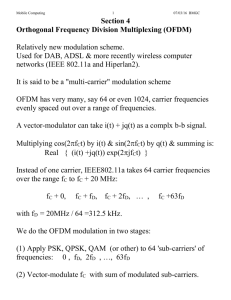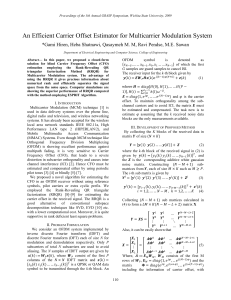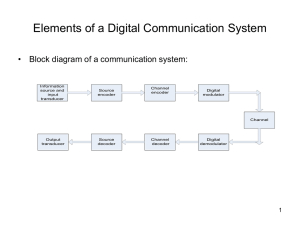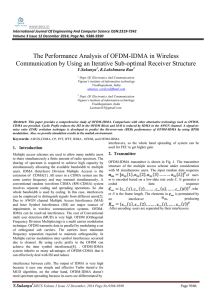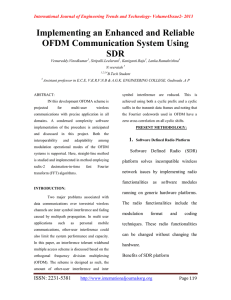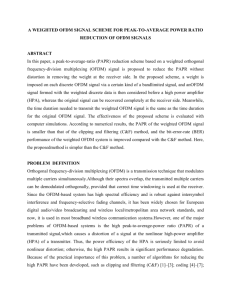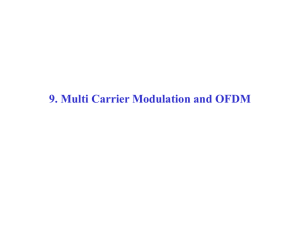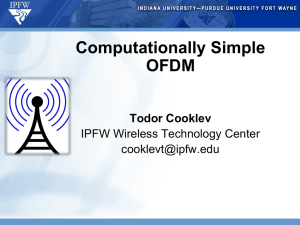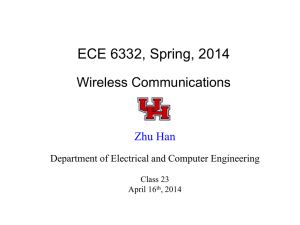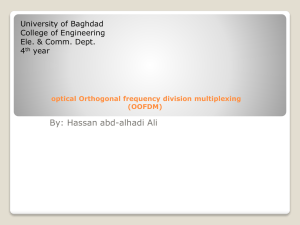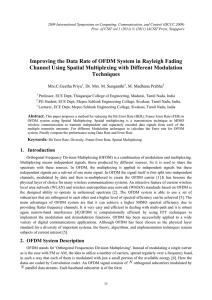PERFORMANCE OF OFDM IN NAKAGAMI FADING
advertisement
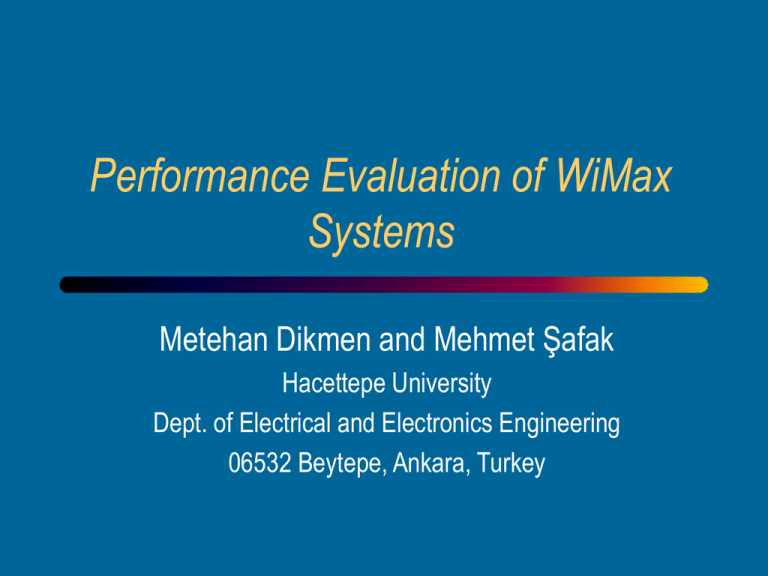
Performance Evaluation of WiMax Systems Metehan Dikmen and Mehmet Şafak Hacettepe University Dept. of Electrical and Electronics Engineering 06532 Beytepe, Ankara, Turkey Outline • • • • Motivation Physical layer IEEE 802.16 extensions WiMax System Model – – – – – Randomization FEC Modulation Interleaving OFDM • Simulation – AWGN channel – Rayleigh fading channel • Results and Conclusions Motivation • WirelessMAN provides network access to buildings through exterior antennas communicating with BSs • Offers an alternative to cabled access networks, – e.g., fiber optic links, coaxial systems using cable modems, and digital subscriber line (DSL) links • Have the capacity to provide high-rate network connections over broad geographic areas without costly infrastructure required in deploying cable links to individual sites • Likely to support nomadic and increasingly mobile users Motivation • Supports different transport technologies, including IPv4, IPv6, Ethernet • The standard achieves high data rates in part via FEC and OFDM techniques • Has a long transmission range because – regulations allow high power transmissions – the use of directional antennas produces focused signals • Transmission range and data rate vary significantly depending on the frequency bands used The Physical Layer • Three types of physical layers are defined: – WirelessMAN-SCa – WirelessMAN-OFDM • A 256-carrier OFDM. • Multiple access of different mobile terminals: TDMA – WirelessMAN-OFDMA • A 2048-carrier OFDM. • OFDMA: Multiple access is provided by assigning a subset of the carriers to an individual user. IEEE 802.16 Extensions • IEEE 802.16a – used in licensed and ISM bands from 2 to 11 GHz. • At the lower ranges, the signals can penetrate barriers and thus do not require LOS between transmitter and receiver • IEEE 802.16b – increases the spectrum in 5 and 6 GHz frequency bands – provides QoS to ensure priority transmission for real-time voice and video – offers differentiated service levels for different traffic types IEEE 802.16 Extensions • IEEE 802.16c – represents a 10 to 66 GHz system profile • IEEE 802.16d (also called as WiMax) – includes minor improvements and fixes to 802.16a. – creates system profiles for compliance testing of 802.16a devices • IEEE 802.16e – standard for networking between fixed BSs and MSs. – would enable the high-speed signal handovers necessary for communications with users moving at vehicular speeds. IEEE 802.l6d Wireless MAN-OFDM • Designed for NLOS operation • Operating frequencies: – 2-11GHz • Channel bandwidths: – 20 or 25 MHz (U.S.) – 28 MHz (Europe) Randomization • Randomization is performed on data transmitted on the downlink and uplink. • For each OFDM symbol randomizer shall be used independently • Pseudo Random Binary Sequence (PRBS) generator : 1 X 14 X 15 Randomization PRBS for data randomization FEC • FEC: – Reed-Solomon, with variable block size and error correction capabilities – RS concatenated with punctured inner convolutional code – Turbo coding is optional – Space-time block codes are optional • Interleaving is also employed FEC • Reed Solomon Code – Derived from a systematic RS (n=255, k=239 T=8) code using GF(m=8) – primitive polynomial specified as: [1 0 0 0 1 1 1 0 1] • Convolutional Code – Coding rate is ½ – Constraint length is 7 – Generator polynomials: • G1=171oct [1111001] • G2=133oct [1011011] Convolutional Encoder Puncturing • Puncturing is applied after CC • 1 means a transmitted bit 0 means a removed bit Channel coding schematic • Modulation schemes: BPSK, QPSK, 16-QAM and 64-QAM • Pulse shaping: Square-root raised-cosine with a rolloff factor of 0.25 Interleaving • Interleaving ensures that adjacent coded bits are mapped onto nonadjacent subcarriers • Block Interleaver with a two step permutations: – mk= (Ncbps/12).k mod12+floor(k/12) k=0,1..Ncbps-1 – jk= s.floor(mk/s)+(mk+Ncbps-floor(12.mk/Ncbps)) mod(s) • De-interleaver is also defined by two step permutations – mj=s.floor(j/s)+(j+floor(12.j/Ncpbs)) mod(s) j=0,1..Ncbps-1 – kj=12.mj-(Ncbps-1).floor(12.mj/Ncbps) OFDM • OFDM symbol is made up from 256 subcarriers: – 192 data subcarriers – 8 pilot subcarriers – 56 null subcarriers: 28 lower, 27 higher frequency subcarriers for guard bands and one DC subcarrier • Pilot subcarriers are used to aid the receiver with synchronization and channel estimation. • Designated ratios of cyclic prefix time to useful time are 1/4, 1/8, 1/16, 1/32 Simulations data In1 Binary Input RS Encoder Out1 Randomizer Convolutional Encoder Viterbi Decoder Binary Output RS Decoder 32,24 32,24,4 Puncture General Block Interleaver General Block Interleaver General Block Deinterleaver General Block Deinterleaver 2/3 Interleaver1 Interleaver2 Deinterleaver2 Deinterleaver1 QPSK QPSK Modulator In1 Out1 OFDM Transmitter Channel Models In1 output Out1 DeRandomizer In1 Out1 insert zero Out1 QPSK In1 Out2 OFDM Receiver QPSK Demodulator AWGN Channel - QPSK AWGN Channel 0 10 Theoretical QPSK1 QPSK2 -1 10 -2 10 -3 BER 10 -4 10 -5 10 -6 10 -7 10 0 2 4 6 E b/N0 (dB) 8 10 12 AWGN Channel - 16 QAM AWGN Channel 0 10 Theoretical 16QAM1 16QAM2 -1 10 -2 BER 10 -3 10 -4 10 -5 10 0 2 4 6 8 Eb/N0 (dB) 10 12 14 Rayleigh Fading Channel - QPSK Rayleigh Channel 0 10 Theoretical QPSK1 QPSK2 -1 BER 10 -2 10 -3 10 0 2 4 6 8 10 E b/N0 (dB) 12 14 16 18 Comparison Coherence Time Eb/N0 1bit duration 1 OFDM symbol duration System without OFDM nearly 0 0.0076 18dB System with OFDM 0.00022 0.006 18dB QPSK without OFDM 0.0038 0.0037 18dB QPSK with OFDM 0.016 0.0027 18dB System with OFDM 0.00022 0 inf QPSK with OFDM 0.015 0 inf • As we did not use pilot carriers for channel estimation, the use of the OFDM has harmful effects to the system varying with coherence time Rayleigh Fading Channel – 16 QAM Rayleigh Channel 0 10 Theoretical 16QAM1 -1 10 -2 10 0 2 4 6 8 10 12 14 16 18 Results and Conclusions • If we use OFDM without channel estimation we are encounter with serious problems in Rayleigh fading channels • Increasing the coherence time makes this worse because of the burst errors • It is obvious that QAM is useless in a Rayleigh fading because of its dependence on amplitude • Our next step will be channel estimation
